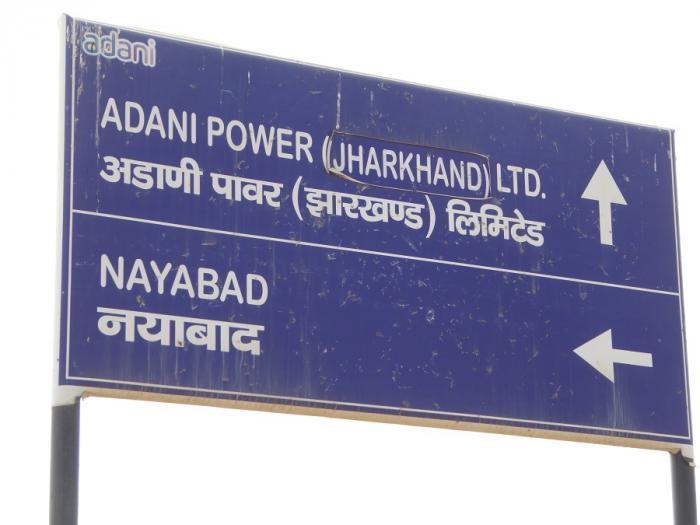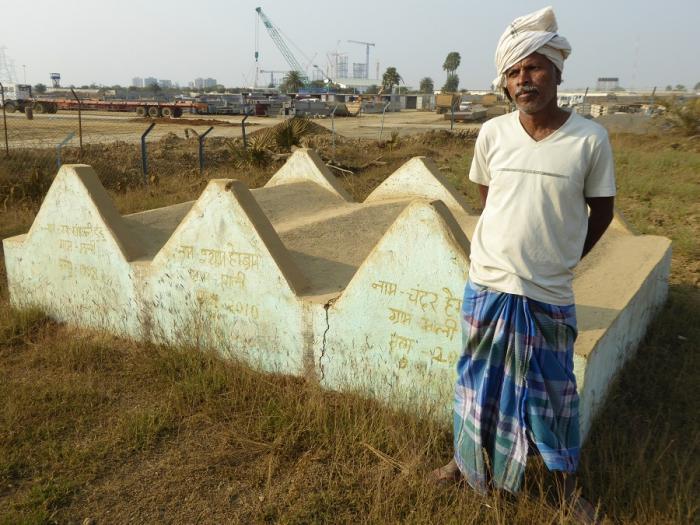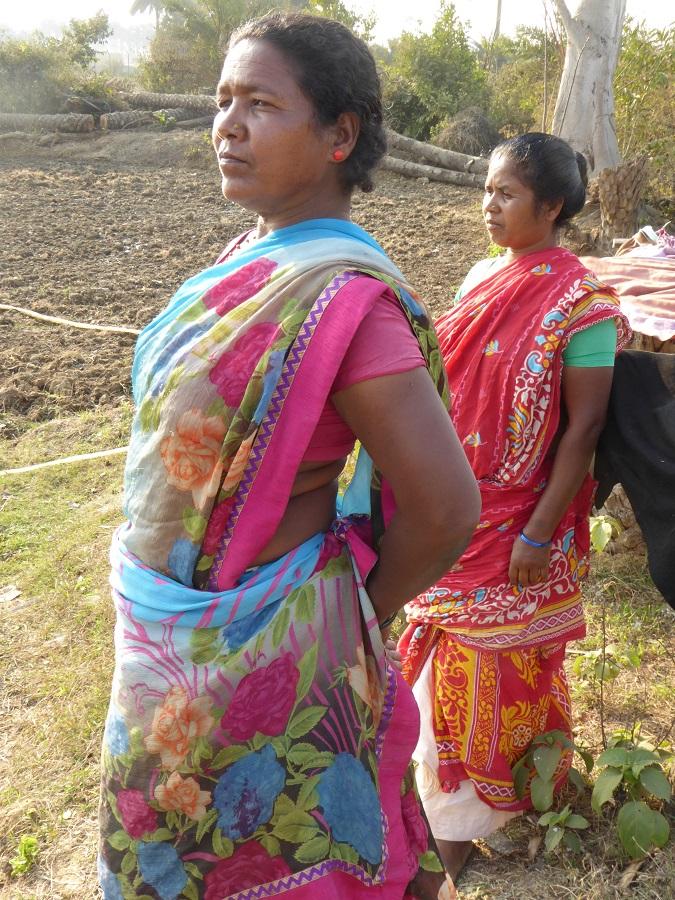Adani Versus Local Villagers – the Battle Over the Godda Power Plant in India
In a remote part of India, a huge and grotesque structure is taking shape against a backdrop of gently undulating pastures, woodlands and crops. This is the Godda power station. It is being rapidly built by Adani to receive coal from the company’s mine in Queensland. The output from Godda will be a massive 1.6 GW, more than the four units comprising the Yallourn power station in Victoria.
Godda is the lynchpin in Adani’s convoluted plan to ship Queensland coal 10,000 km so that power can be generated in India and sold across the border to Bangladesh. Godda is 600 km from the nearest port and hundreds of kilometres from the nearest major city. Despite its importance to the Stop Adani campaign, the situation at Godda has been shrouded in mystery, with few clear indications of Adani’s progress in constructing its power plant. To find out what was going on there, AdaniWatch went to take a look in February 2020. I was accompanied by Abir Dasgupta, a free-lance Indian journalist and contributor to a book on Adani to be published this year, who set up a vigorous schedule of meetings and interviews, organising, recording and translating as we went.
Our first shock occurs when we are still more than 300 km from Godda, in the provincial capital Ranchi. Two knowledgeable people, a local lawyer and a member of the legislature, inform us that Adani’s power plant is 40% complete. This is completely at odds with earlier reports that Adani had managed little more than clear the land and assemble some office buildings. If the plant is already 40% complete, then Adani is clearly well on the way to meeting its schedule to start generating power from Queensland coal in 2022.

The sign points the way to the construction site for Adaniâs Godda power plant, being built to consume Australian coal for export to Bangladesh. Photo by Geoff Law.
Offsetting this news are descriptions of the ways in which local people are defying Adani in the courts, where a flurry of different actions is underway. To speak to them, we travel to the village of Gangta, hoping to get photos of Adani’s construction site while we’re there. We know we have to be careful while in this area. We have been warned that companies such as Adani carry out their own surveillance using security companies from the USA and Israel, as well as employing local goons to ‘protect’ their sites from the intrusive eyes of journalists. Stories abound of foreigners who, while covering contentious issues in India, have been confronted by security personnel and run out of town.
First, we rendezvous with Inam Ahmed, a feisty local lawyer who is representing several of the residents who are refusing to concede their land, on the main street of Godda. With a population of about 100,000, Godda is like other small Indian cities – it’s noisy and polluted. The combination of loud machines, manic tooting of horns, diesel fumes and coal smoke from cooking fires leaves me feeling dazed. We wait in the hot sun for Balesh Pandey and Ramji Paswan. Balesh’s father is among those who have had their land acquired for the power project – he was shown as dead in official papers and thus the requirement to secure his consent waived. He is very much alive. Paswan’s land is also sought to be acquired. He has filed a police complaint accusing Adani of a caste atrocity under an Indian law meant to protect the ‘scheduled’ castes and tribes, communities that are traditionally outside the Hindu caste hierarchy, and still subject to the practice of untouchability and daily violence. Balesh and Ramji will accompany us to the villages adjoining the project. Once they arrive, we leave in a three-wheel autorickshaw, contributing our own noise to the proceedings.
We putt-putt along the main road out of town, past some huge earthworks that Inam says are for Adani’s Godda rail link, and turn onto a side road. Before long, there are signs pointing the way to Adani’s power plant, under the formal name Adani Power (Jharkhand) Ltd. We turn off again, following a newly-erected wall that obscures our view of the construction site. A village appears – a collection of humpies, smoky cooking fires and dinghy stalls selling plastic packets of stuff. Idle men and scrofulous dogs lounge around amongst the rubbish. But this is not Gangta. It’s a shanty town that appeared next to Adani’s wall shortly after construction commenced. Balesh informs us that all these men are ‘outsiders’ - not locals.
We leave the shanties behind, wind amongst fields and trees, and pull up outside a temple. Beneath the spreading foliage of a sakwa tree is a welcoming committee. Further away, along a path framed by a wooden arch and lined by vegetation, are the neatly arranged houses of Gangta and the adjacent village Govindpur. The relative quiet is a blessed contrast to the cacophony of Godda.
We remove our shoes and seat ourselves on mats in the shade. Across the way, a white-haired man washes his thin legs with water pumped up from a well. A woman leads a couple of big white cows past a group of children. The fields are dotted with mango trees, their lower limbs pruned to a straight horizontal line by grazing animals. Another old man – Bhagat – arrives on a bicycle and joins our group. We will soon learn that he is one of the fiercest activists in the movement to prevent confiscation of land for the power project.
Villagers affected by the confiscation of their lands for Adaniâs power plant. In front is Ramji Paswan, a retired teacher in a government school and farmer. He has filed an atrocity complaint with the police regarding his treatment during the land confiscation furore. Photo by Geoff Law.
For an hour and a half, we sit and discuss the details of the government’s acquisition of these people’s land on behalf of Adani – the type of land, the value of it, the inadequate compensation, the various legal measures being taken to uphold their rights. The conversation occurs in Hindi. I take in the surroundings and observe the group of about 15 people who have spared us their time. They are mostly older people, members of an ‘adivasi’ tribe, an indigenous community whose status is recognised by law. They have been carrying on this battle for several years but their indignation has not dimmed. From time to time, their responses become angrily animated; at other times there is grim laughter. To one side sits a small group of women. They remain silent and I wonder how many times they have heard their story told to journalists who listen, record and then leave.
The land has been in these people’s families for generations. It’s fertile, yielding up to four crops a year. It provides a living for the villagers – direct food and then cash from the sale of the excess. The loss of land undermines their economic security. But it’s not just livelihoods affected. Land ownership allows people to get health services and to get their children married. Loss of land threatens these things.
There are other impacts of Adani’s encroachment, in particular, the degradation of domestic water supplies. We are shown water pumped from a well that runs red; it leaves a dirty residue in cooking pots. This is because Adani’s consumption of water for its construction works has lowered groundwater to the level of iron-rich bedrock.
Though no one has yet been forced to move away from the village, they say that the degradation of water supplies is a signal that this will happen soon. I ask where people will go. After the question is translated, there’s an uncomfortable silence. It’s a prospect difficult to confront. Eventually, it’s said that many would have to seek labouring work in the cities. They will be scattered. It becomes clear that taking away their land will dismantle the adivasi tradition and a whole way of life.
In the background is the rumbling of machinery – they say it goes 24 hours a day. It destroys their peace of mind in more ways than one. Before construction started, they could leave bales of hay where they were made; livestock could be left untended at night; women could work freely in the fields or walk safely from one village to another. But the labour force brought in from outside to work on the power station has changed all that. Many of the men are ‘gunda’ – ruffians. They drink alcohol, disrespect women and steal things.
Later I learn that their movement has weakened since the local legislator who was leading them was arrested and thrown in jail for six months in 2017. Several sold their lands; their unity was diminished. Inam notes to us in English, privately, that the group made the mistake of not filing lawsuits right at the beginning. However, these folk are standing firm.
The discussion finishes. We leave the shade of the tree and walk through a thicket of flowering lentil plants, through some rice fields and then amongst thatched-roof houses. Colourful clothes and rugs are airing in the sun. Women bend to wash clothes with water pumped from a well. The noise of machinery gets louder and soon there’s the sight of trucks trailing great plumes of dust. Piles of building components are stacked on the other side of a big barbed-wire fence. Further away are metal shipping containers. In the distance looms the complex framework of the power station, a vertical grid 20 storeys tall topped by giant cranes.
We pick our way down to the fence past a field of corn, the thin stalks of onions, a patch of cauliflower and more lentils. But now all the leaves of these crops are coated with dust. At the fence, this field of plenty stops abruptly. We peer balefully across at the sinister apparition that dominates the skyline.
We are standing on the property of Suryanarayan Hembrom, one of the remaining villagers who has stood firm against his land being acquired. It is now bordered on three sides by Adani’s construction site. At one point the company attempted to fence off his fields with barbed wire. He pulled down the fencing and we walk past its piled-up remains.

An adivasi farmer stands at the graves of his father, mother and brother just metres away from what is now Adaniâs Godda construction site. Photo by Geoff Law.
This was the site of a visceral encounter between Adani and the locals, footage of which has been shared far and wide on the internet. On 31 August 2018, an Adani official was confronted by a throng of villagers distraught at the imminent loss of their land. Some of the women threw themselves at the feet of the official, pleading with him not to go through with the confiscation. Aided by a man wearing army fatigues, the official pried the women’s hands away from his feet.
Now, a year and a half later, one of the women, Sita Murmu, stands at the same place, looking across the fence at the permanently ruined land. She remains silent, radiating a stoic dignity.
Later we drive away from Gangta, winding around Adani’s wall for a closer look at the construction. Dump trucks and company cars jostle for position with the gentler traffic of tractors, cows and bicycles on the narrow roads. We pass three company employees using long sticks to place barbed wire – unfurling gradually from a shiny coil – on top of the wall. We round a bend or two, the noise and traffic increase, and our little three-wheeler pulls up on a hillock topped with gravel, parked trucks and swirling dust. As we get out, we’re eyed by workers wearing helmets and high-viz jackets. Other men emerge from a collection of shanties. Amplified pop music blares from one of the stalls. We uneasily scurry across a stubbly field to a two-storey building, climb some stairs and emerge onto a terrace from where there’s a panoramic view across the entire construction site, from big apartment blocks over on the right to large cylinders sprouting from the rubble on the left. Towering over everything is the huge metal scaffold with its predatory cranes. We take some pictures.
I learn that the building we’re in is an ashram; it used to be the meeting place for people opposed to Adani’s project. We sip tea for a while and then our driver appears. He has been confronted by a group of men up at the parking site. We go with him back to the vehicle where the ruffians, wearing casual clothes and smirking with false bonhomie, are picking on Balesh, our young companion. Inam, the lawyer who has taken us on this tour, forcefully remonstrates with them. A heated exchange ensues.
Later I learn that, on giving his name, one of his adversaries said ‘so you’re a Muslim’ to which Inam responded ‘well if you’re going to kill me, kill me now’ and proceeded to enumerate all the reasons why that would be a very bad idea. This encounter vividly illustrates the current political situation in India, where the Hindu nationalist ruling party is taking legislative measures that many believe are designed to marginalise people of Muslim descent.

Sita Murmu and a relative look across at the destruction of their lands by Adaniâs Godda power plant. They are standing at the site of a confrontation between farmers and Adani in 2018 when Sita threw herself at the feet of the Adani official carrying out the confiscation of their lands. Photo by Geoff Law.
We manage to separate our young companion from the gang of Adani-supporters. I’m hoping for a quick departure but watch in amazement as our driver removes a length of hemp rope from the back of the three-wheeler, attaches it to something underneath the vehicle, and starts tugging.
‘So this is our getaway car?’ I say to no one who can understand.
Inam grabs the rope and, with the driver, gives a forceful tug. The vehicle splutters into life. While it is being turned around, Inam continues to engage our interlocutors with vigour. By now, the group knows they are dealing with a feisty local lawyer and give up the battle. We pile into the vehicle and drive off.
But the encounter is not over. Inam has managed to contact a senior official of the plant on his phone and delivers a non-stop tirade. He and his companions have been threatened. He is going to the police to make a complaint. An apology is necessary. There is now worldwide interest in Godda, so Adani had better not make any wrong moves.
We drive away from the power plant, turning on to a bigger road and joining the normal stream of traffic. The sun is setting. There’s a rosy glow in the sky.
Inam’s vociferous monologue continues. After a few kilometres, a big company four-wheel-drive overtakes us, signalling for us to pull over. A couple of casually well-dressed men get out and swagger across to us – one wearing a pink shirt is said to be Adani’s site manager. They stand by the side of the road with Inam and argue it out. After 15 minutes of Inam’s voluble indignation, their shoulders begin to slump.
On the road, life goes on. An ageing tractor pulls a cart laden with hay. Motorbikes honk repeatedly. A group of young women in immaculate colourful saris chatter together, walking by without sparing us a glance. A white-haired man in a saffron suit cycles serenely past.
On the right-hand skyline is the hulking skeleton of Adani’s power plant, its lights turning on in the twilight.
Geoff Law on location in India in Feb 2020, with critical contributions from Abir Dasgupta. The views are personal.
Get the latest reports & analysis with people's perspective on Protests, movements & deep analytical videos, discussions of the current affairs in your Telegram app. Subscribe to NewsClick's Telegram channel & get Real-Time updates on stories, as they get published on our website.
























